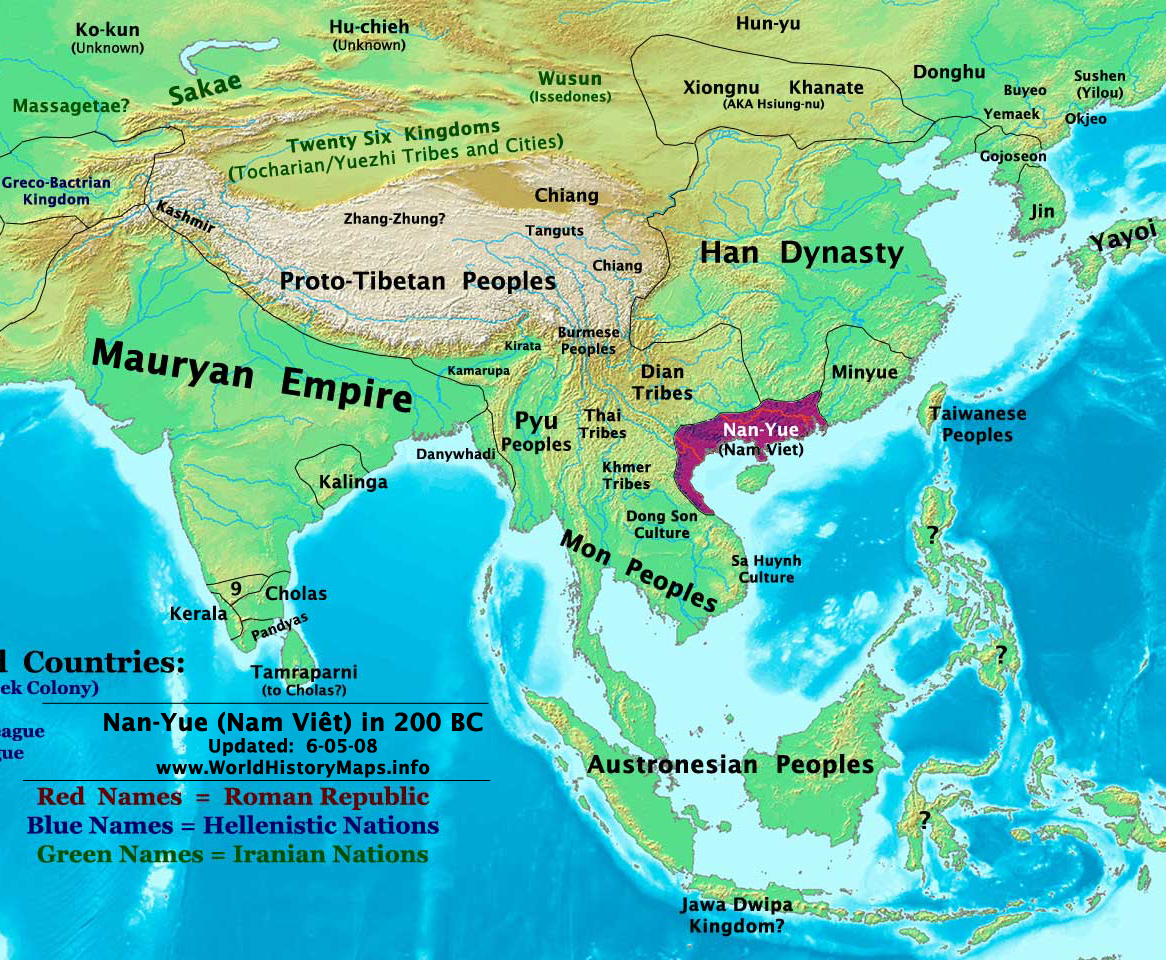https://www.worldhistorymaps.info/wp-content/uploads/2021/03/nan-yue_200bc.jpg
Nanyue (Chinese: 南越; pinyin: Nányuè, also called Southern Yue), or Nam Việt (Vietnamese: Nam Việt; Zhuang: Namzyied), was an ancient Chinese (and Vietnamese) kingdom that covered the modern Chinese subdivisions of Guangdong, Guangxi, Hainan, Hong Kong, and Macau, as well as parts of southern Fujian and northern Vietnam. Nanyue was established by Zhao Tuo, then Commander of Nanhai of Qin Empire, in 204 BC after the collapse of the Qin dynasty. At first, it consisted of the commanderies Nanhai, Guilin, and Xiang.
In 196 BC, Zhao Tuo paid obeisance to the Emperor Gaozu of Han, and Nanyue was referred to by the Han dynasty as a “foreign servant”, i.e. a vassal state. Around 183 BC, relations between the Nanyue and the Han dynasty soured, and Zhao Tuo began to refer to himself as an emperor, suggesting an equal status between Nanyue and the Han dynasty. In 179 BC, relations between the Han and Nanyue improved, and Zhao Tuo once again made submission, this time to Emperor Wen of Han as a subject state. The submission was somewhat superficial, as Nanyue retained autonomy from the Han, and Zhao Tuo was referred to as “Emperor” throughout Nanyue until his death. In 113 BC, fourth-generation leader Zhao Xing sought to have Nanyue formally included as part of the Han Empire. His prime minister Lü Jia objected vehemently and subsequently killed Zhao Xing, installing his elder brother Zhao Jiande on the throne and forcing a confrontation with the Han dynasty. The next year, Emperor Wu of Han sent 100,000 troops to war against Nanyue. By the year’s end, the army had destroyed Nanyue and established Han rule. The dynastic state lasted 93 years and had five generations of monarchs.
The existence of Nanyue allowed the Lingnan region to avoid chaos surrounding the collapse of the Qin dynasty. It allowed the southern region to avoid much of the hardship experienced by the northern, predominantly Han Chinese regions. The kingdom was founded by leaders originally from the Central Plain of China, and was responsible for bringing Chinese-style bureaucracy, advanced agriculture and handicraft techniques to inhabitants of southern regions, as well as knowledge of the Chinese language and writing system. Nanyue rulers promoted a policy of “Harmonizing and Gathering the Hundred Yue tribes” (Chinese: 和集百越), and encouraged ethnic Han to immigrate from the Yellow River region to the south. Nanyue rulers were then not against the assimilation of Yue and Han cultures.
In Vietnam, the rulers of Nanyue are referred to as the Triệu dynasty. The name “Vietnam” is derived from Nam Việt, the Vietnamese pronunciation of Nanyue.
Source: Wikipedia

